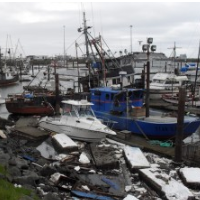Seldom Seen Tsunamis Pose Threat to Quarter Million Californians
 Crescent City marina after March 2011 tsunami (photo: U.S. Coast Guard)
Crescent City marina after March 2011 tsunami (photo: U.S. Coast Guard)
Tsunamis have always posed a credible threat to California, but delivered little destruction over the past 150 years compared to other natural disasters like earthquakes or fire.
However, a report just released by the U.S. Geological Survey says 267,347 residents are sitting in a 20-county tsunami zone that is “likely to experience” the kind of devastation suffered by Samoa in 2009,
“Historical and geologic evidence indicate that the California coast has experienced similar large-magnitude tsunamis,” the report says. It makes no attempt to predict when or where a tsunami might hit. A tsunami caused significan damage in Crescent City, Santa Cruz and other parts of Northern California in March 2011 after a devastating earthquake rocked Japan.
Humboldt County has the most land in the tsunami-inundation zone, but it is mostly undeveloped property. Developed areas most at risk are in the counties of Alameda, Los Angeles, Orange and San Diego. Most of the land in the study area is medium- and low-intensity developed with residential housing and associated buildings like garages and sheds.
Among cities, Alameda, Belvedere and Crescent City have the highest relative exposure to tsunamis based on their exposed populations and assets. They are followed by Emeryville, Oakland, Long Beach, Seal Beach, Huntington Beach, Newport Beach, Eureka, Sausalito and Los Angeles.
The quarter-million residents at risk live in 117,380 residences, about half of which are rental units. About 15.5% of them are over 65, considered to be among the most at-risk population.
More than 15,000 businesses and 168,000 employees occupy the zone. Many of these businesses, by virtue of being near the ocean, attract a lot of tourists and visitors. That would complicate any evacuation efforts. Some high-occupancy venues include: the Monterey Bay Aquarium; Santa Cruz Beach Boardwalk; public piers in Santa Monica, Redondo Beach, Santa Barbara and Pismo Beach; the Catalina Casino in Avalon; and cruise ship terminals in the Los Angeles and Long Beach ports. More than 90 parks lie in the zone.
Tsunamis are extremely long waves that can travel hundreds of miles after being triggered by an earthquake, volcanic eruption, landslide or, if one chooses to be truly apocalyptic, asteroid impact.
The California coast has had 14 tsunamis since 1812 with waves higher than three feet. Six of them caused destruction. A big tsunami struck the Channel Islands in the early 1800s but the worst hit after being generated by the 1964 Alaskan earthquake, which killed 12 people and caused at least $17 million in damages to northern California.
–Ken Broder
To Learn More:
New Study Highlights California Tsunami Risk (Agence France-Presse)
The Tsunami Threat to California (California Seismic Safety Commission) (pdf)
Community Exposure to Tsunami Hazards in California (by Nathan J. Wood, Jamie Ratliff and Jeff Peters, U.S. Geological Survey) (pdf)
- Top Stories
- Controversies
- Where is the Money Going?
- California and the Nation
- Appointments and Resignations
- Unusual News
- Latest News
- California Forbids U.S. Immigration Agents from Pretending to be Police
- California Lawmakers Urged to Strip “Self-Dealing” Tax Board of Its Duties
- Big Oil’s Grip on California
- Santa Cruz Police See Homeland Security Betrayal in Use of Gang Roundup as Cover for Immigration Raid
- Oil Companies Face Deadline to Stop Polluting California Groundwater





